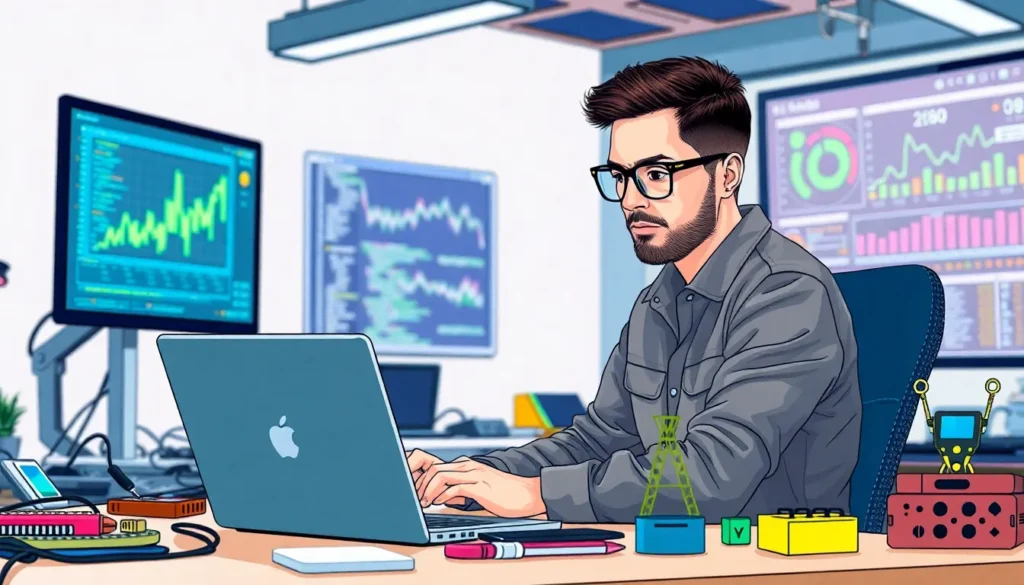Table of Contents
ToggleIn a world where your toaster might just be plotting world domination, the role of an IoT developer has never been more crucial. These tech wizards connect everyday devices to the internet, transforming them into smart gadgets that can talk, listen, and even argue with you. Imagine your fridge reminding you to buy milk while your thermostat adjusts the temperature based on your mood—sounds like magic, right?
But it’s not just about creating cool gadgets. IoT developers are the unsung heroes behind the curtain, crafting seamless experiences that make life easier and more efficient. With the Internet of Things rapidly expanding, the demand for skilled developers is skyrocketing. So if you’ve got a knack for coding and a love for innovation, stepping into the world of IoT might just be your ticket to shaping the future—one smart device at a time.
Understanding Iot Development
IoT development involves creating innovative solutions that enable devices to communicate. This field combines hardware, software, and networking to enhance user experiences.
What Is An IoT Developer?
An IoT developer specializes in building and maintaining IoT solutions. They design applications that allow devices to collect and share data. These developers work with various technologies, including sensors, microcontrollers, and cloud services. Their expertise addresses the integration of different systems and protocols, ensuring seamless device communication. Additionally, IoT developers often collaborate with engineers and data scientists to create robust, scalable applications tailored to specific needs.
Key Skills Required
Key skills for IoT developers include proficiency in programming languages such as Python, Java, and C++. They should understand networking protocols like MQTT and HTTP, which facilitate device communication. Knowledge of cloud technologies, including AWS and Azure, proves essential for managing data storage and processing. Troubleshooting and problem-solving abilities enhance their effectiveness in developing robust solutions. Familiarity with data analytics also supports optimizing the performance of IoT applications. Continuous learning ensures IoT developers stay updated with rapid technological advancements in this dynamic field.
Tools and Technologies for Iot Development

IoT developers rely on various tools and technologies to create and manage smart devices. Certain programming languages and platforms play a crucial role in the development process.
Programming Languages
Python, Java, and C++ are popular choices among IoT developers. Python’s simplicity and extensive libraries make it suitable for rapid development. Java offers portability across devices, which benefits cross-platform IoT applications. C++ provides control over system resources, ensuring efficient performance in constrained environments. Additional languages like JavaScript and Go also gain traction for their flexibility and speed in writing scalable IoT solutions.
IoT Platforms and Frameworks
Several IoT platforms simplify the development process by offering integrated solutions. AWS IoT, Microsoft Azure IoT, and Google Cloud IoT are prominent cloud platforms that facilitate device management and data processing. These platforms support various devices and protocols, enabling developers to focus on application logic rather than infrastructure. Frameworks like Node-RED and Kaa offer intuitive tools for building IoT applications and managing device connectivity, streamlining development workflows.
The Role of An Iot Developer
IoT developers play a crucial role in creating innovative smart solutions. These professionals are responsible for developing applications that allow devices to communicate and operate efficiently.
Types of IoT Applications
IoT applications vary widely across different industries. Smart home systems automate everyday tasks, improving convenience for users. In healthcare, wearable devices monitor patient health metrics, potentially saving lives. Transportation apps enhance logistics by tracking fleet movements in real-time. Agriculture applications utilize sensors for precision farming, optimizing crop yields. Each type of application highlights the versatility and potential impact of IoT technologies.
Collaboration with Other Professionals
Collaboration involves working closely with various professionals. Software engineers contribute their expertise in coding and system architecture, ensuring robust applications. Data analysts interpret device data, gaining insights to improve functionality and user experience. Hardware engineers design the physical components, integrating sensors and devices effectively. Project managers oversee timelines and resources, coordinating efforts across teams. This teamwork fosters innovation and drives successful IoT solutions.
Challenges Faced by Iot Developers
IoT developers encounter several challenges that impact their work and the effectiveness of their solutions. Primary challenges include security and scalability.
Security Concerns
Security concerns represent a significant challenge for IoT developers. With numerous devices interconnected, vulnerabilities arise that hackers could exploit. Each connected device introduces potential entry points for malicious activities. Developers must implement robust security measures, such as encryption, authentication, and regular software updates, to safeguard user data. The complexity of securing multiple devices complicates the development process, requiring constant vigilance to ensure the integrity of systems. A focus on security throughout the development lifecycle becomes crucial for preventing security breaches and maintaining user trust.
Scalability Issues
Scalability issues frequently arise as IoT solutions expand. Developers must ensure that systems can handle increased data loads as user demand grows. Proper architecture and robust design principles are essential in addressing scalability challenges. Limited resources may restrict performance, making optimization necessary for seamless operation. Developers often encounter difficulties when integrating new devices into existing networks. Continuous scalability testing is vital in identifying potential bottlenecks and ensuring that applications can grow alongside technological advancements. Managing scalability effectively enhances the user experience and prepares solutions for future demands.
Future Trends in Iot Development
Growing integration of artificial intelligence (AI) and machine learning (ML) technologies enhances IoT functionality. Devices increasingly learn from data patterns, enabling predictive analytics and automated decision-making. Enhanced efficiency results from utilizing real-time data processing, allowing applications to respond intelligently to user needs.
Edge computing is rising in prominence, enabling data processing closer to the data source. This method reduces latency and bandwidth usage, improving system response times. Developers leverage edge devices to create faster and more responsive IoT solutions, particularly in industries like healthcare and manufacturing.
5G connectivity reshapes the IoT landscape significantly. Faster data transfer rates and increased connection density allow for more devices to operate simultaneously. Smart city applications, for example, can thrive with low latency and high-speed networks, leading to improved urban infrastructure.
Emphasis on enhanced security features will dominate future IoT developments. Rising threats necessitate implementing advanced encryption techniques and privacy protocols. Developers prioritize security by integrating methods such as biometric authentication to safeguard user data effectively.
Sustainability trends influence IoT development as well. Devices aim to optimize energy consumption and reduce waste, aligning with environmental initiatives. Renewable energy sources become integrated into IoT applications, promoting green technologies and sustainable living.
Interoperability remains a vital focus, as diverse devices must communicate seamlessly. Standardization of protocols enhances compatibility among different manufacturers. Developers engage in collaborative efforts to create unified ecosystems, enriching the user experience.
Market demand for IoT solutions increases across various sectors. Industries like agriculture, logistics, and healthcare seek tailored IoT applications to drive efficiencies. Developers stay ahead of trends to meet evolving consumer expectations and advance the IoT ecosystem.
The role of an IoT developer is pivotal in shaping the future of technology. As smart devices continue to proliferate, the demand for skilled developers who can create innovative solutions grows. Their expertise not only drives advancements in various industries but also enhances user experiences through seamless connectivity and functionality.
With a focus on continuous learning and adapting to emerging trends, IoT developers can stay at the forefront of this dynamic field. By embracing challenges like security and scalability, they contribute to building robust systems that meet the evolving needs of consumers. As the landscape evolves, those passionate about technology have a unique opportunity to make a significant impact in the world of IoT.







